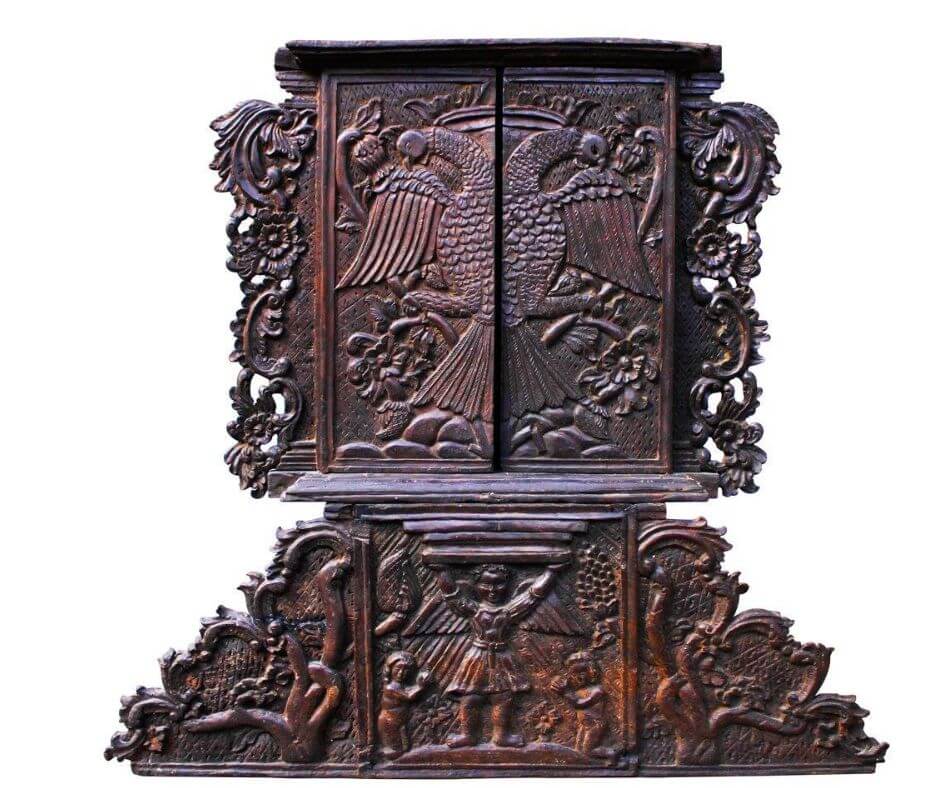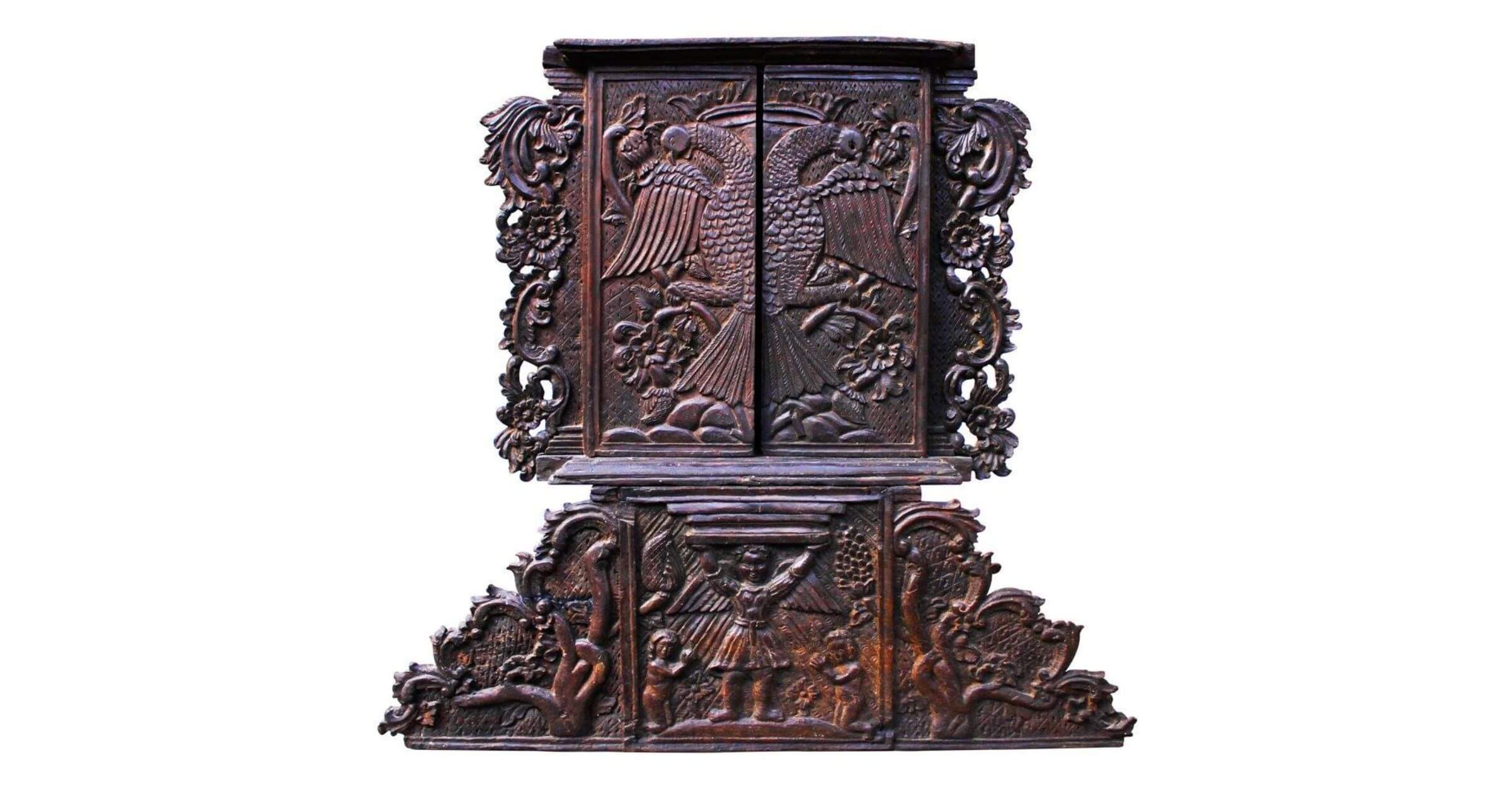This urna or tabernacle was reported to have been sold for P1.44 million, inclusive of commission, in 2017. This was briefly mentioned during the discussion among Cebu Governor Gwendolyn Garcia, NCCA Chair Ino Manalo, Commissioner Ivan Henares, and Dr. Jobers Bersales last Wednesday evening.

It’s probably in the Philippines, Dr Bersales said after Gov. Garcia asked about it. This is definitely from the Boljoon church, according to several experts I asked. Its provenance was listed as “Church of La Patrocinio de la Virgen Maria Boljoon, Cebu” on the Facebook page that shared about the sale and a Flickr photo post.
This urna was offered to a member of a prominent Cebuano family, a source told me. That member then consulted a heritage expert who warned, “Don’t touch that.”
The large Hapsburg Eagle with a crown carved on the doors is the symbol of the Augustinian Order, which administered Boljoon until 1948.
The tabernacle is reportedly from the collection of David Kamansky, former Pacific Asia Museum director. Kamansky had it from 1977-2003, according to information posted online along with this photo. Noteworthy that the late Fr. Miguel Ortega, who was accused of stealing relics and antiques from the church, was parish priest of Boljoon from 1976 to 1982. But the item was not mentioned in the affidavits of those who served as witnesses in the estafa and qualified theft cases filed against him that were later dismissed.
Kamansky was mentioned in a The New York Times story last January 26, 2008 with the title “Museum Workers Are Called Complicit.” According to the article, Kamansky “visited a warehouse maintained by Robert Olson, who investigators say illegally smuggled large numbers of artifacts out of Thailand and arranged for their sale or donation to museums, including the Pacific Asia Museum.”
According to information that came with the published photo, “This tabernacle or urna, made entirely of molave, is said to have come from the church of Boljoon in Southern Cebu. Stylistically, it is a transition piece showing Baroque details in conjunction with the Rococo Style elements that began to manifest itself in Philippine art after the 1750s. The piece was originally used to enshrine a religious statue. Originally, this urna was undoubtedly gilded with gold leaf and painted in polychrome. The paint and gilding were probably damaged by time and, when collecting such objects became fashionable in the 1970s, they were stripped away and varnished to expose the wood.”
“The base is a false front consisting of an upright wooden panel carved with a central relief of an angel with outstretched wings holding aloft what seems to be the base of the tabernacle above it. Kneeling on either side of the angel is a naked, kneeling figure of a man and a woman in an attitude of prayer symbolizing Adam and Eve. Flanking the panel are symmetrical carvings of a tree with curving and interlacing branches terminating with stylized leaves in the form of foliated C-scrolls of various sizes forming the upward tapering edge of the carved panel. Although the scrolls bear the imprint of the Rococo, the flowers, however, are still those of the earlier Baroque style.”
“The tabernacle has a pair of wooden doors carved with a large double-headed eagle beneath a crown, the logo of the Augustinian Order in the Philippines. The bird is perched on a flowering and fruiting pomegranate tree growing on a rocky ground. The pomegranate or granada with its numerous seeds inside one fruit is the symbol of the Church having many souls in one body. The entire background of the relleve or relief carving is diapered and stippled in typical rococo taste. Flanges attached to the sides of the door frames are carved with foliate scrolls alternating with a pomegranate flower with the inner reserves also diapered and stippled. The urna originally had an elaborate crest which has disappeared.”
Can this be recovered? Among the things discussed in Wednesday’s meeting at the Capitol is a long-term solution to provide a mechanism by which items such as this one are returned to the Church. Otherwise, the collector will face penalties. (More on this soon.)
Max is a journalist and blogger based in Cebu. He has written and edited for such publications as The Freeman, The Independent Post, Today, Sun.Star Cebu, Cebu Daily News, Philstar Life, and Rappler.
He is also a mobile app and web developer and co-founded InnoPub Media with his wife Marlen.


Leave a Reply